Mining bees (
Andrena) are a diverse genus of bees common in urban and suburban gardens. The majority of mining bee species are active in spring. Like most solitary, wild bees, mining bees nest in the ground and seek out a spot with little vegetation and open, bare soil. These gentle, ground-nesting bees often construct their nest in lawns — and so maintaining a pesticide-free lawn and garden helps ensure their survival. Mining bees are not aggressive, and it is very rare to be stung by a mining bee, because their sting cannot penetrate human skin.
Spring-emerging females work their way through the woodland understory collecting pollen and nectar from woodland wildflowers, shrubs and trees. Many mining bees are oligolectic, or specialists; the females collect pollen only from a specific family of plants or, more narrowly, a particular genus of plants. If you provide some patches of bare ground and many of their favorite forage plants, including plants sought after by specialist mining bees, these beautiful bees will not be able to resist visiting your garden.

Holm Design & Consulting LLC
Family: Andrenidae
Subfamily: Andreninae
Genus: AndrenaNumbers: Approximately 30 subgenera and 480 species in North America (north of Mexico), including one introduced species; 120 species east of the Mississippi and over 1,500 species worldwide
Distribution: Mining bees are found throughout the Northern Hemisphere, including Europe, North America, southern Africa and limited areas in Asia; they are very common throughout the U.S. and southern Canada.
Habitat: Woodland edges, gardens, meadows, prairies and old fields
Shown: A female mining bee on American plum (
Prunus americana). This photo illustrates where mining bee females collect pollen: on the lower part of the hind leg, as well as higher up on the hind leg and the side of the thorax, giving the appearance that pollen is collected in their “armpit.”
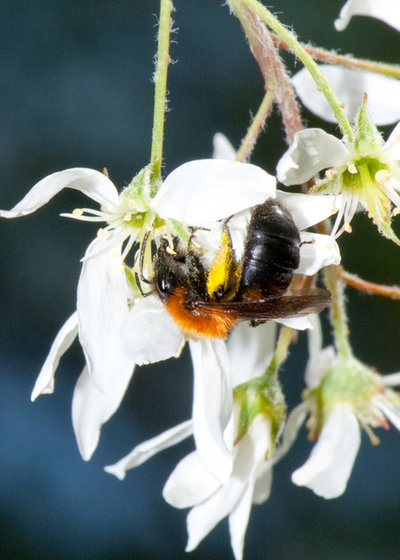
Holm Design & Consulting LLC
When to look for them: Spring is the optimum time to observe mining bees. The majority of mining bee species are active in the spring and are responsible for pollinating many woodland wildflowers as well as early-flowering native shrubs, such as viburnums (
Viburnum spp) and dogwoods (
Cornus spp). Mining bee activity is low during the summer. In the fall, activity increases again as fall species emerge.
Many of the summer- and fall-occurring species are specialists; the females seek out pollen from a narrow range of plants from a particular plant family or, in some cases, more narrowly from a particular plant genus. Many of the fall-emerging mining bees are specialists of plants in the Asteraceae family. These Asteraceae specialists, as well as fall-occurring generalists, commonly visit goldenrods (
Solidago spp) and asters (any species).
Shown: A Milwaukee Andrena (
Andrena milwaukeensis)
visiting downy serviceberry (
Amelanchier arborea) in late spring
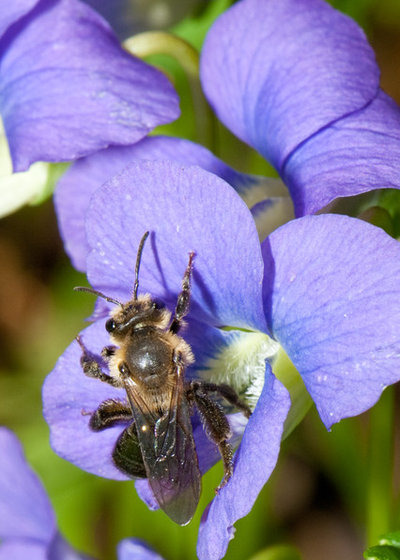
Holm Design & Consulting LLC
How They HelpMining bees are very effective pollinators of many types of plants. Their medium size and ability to release pollen by vibrating flowers at a high frequency (called buzz pollination) allow them to visit both simple and relatively complex flower forms. Blueberry growers have known for a long time the importance of mining bees; they are one of the primary pollinators of cultivated and wild blueberries.
Mining bees, like all bees, need a continuous succession of flowers in the garden and a variety of flower forms and colors. Females expend a lot of energy during nest building and provisioning, and therefore require an ongoing supply of pollen and nectar to fuel their activities, as well as to provide food for their offspring.
Shown: A neighborly Andrena (
Andrena vicina)
visiting common blue violet (
Viola sororia) — a good reminder that even commonly occurring plants such as violets can provide forage for bees, especially in early spring
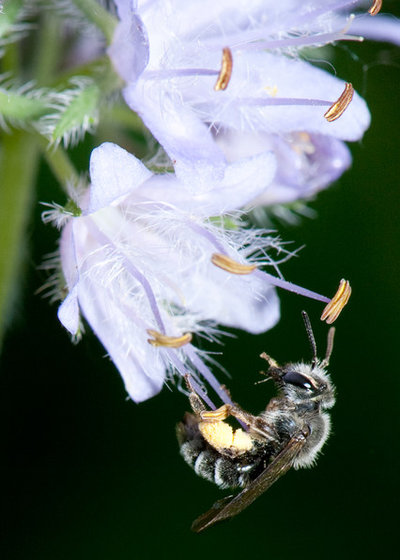
Holm Design & Consulting LLC
How to Spot Mining BeesAdults. Mining bees vary in size; the small species are approximately 1/10 inch (5 millimeters) long, and the largest mining bees are 5/16 inch (18 millimeters) long. Most adults are black, with white, gold or orange-colored hairs on the head and thorax, and have abdomens that range from hairy to hairless.
One distinguishing feature in females is the two depressions (foveae) between their large (compound)
eyes on their face. These depressions are typically filled with felt-like hairs; the hair color in the foveae is often a different color than the hair on the head, giving the appearance of two vertical stripes on the face. Females collect pollen on hairs on their tibia, femur and trochanter on their hind legs as well as on their propodeum (side of the thorax). Compared with many other wild bees that collect pollen on the lower portion of the hind leg, with mining bees the pollen collection is on a noticeably higher spot, closer to the thorax.
Babies (larvae). Larvae are grub-like and are pale yellow to cream in color. It is unlikely you will see larvae, as all mining bees nest belowground.
Shown: A Geranium Andrena (
Andrena geranii)
visiting Virginia waterleaf (
Hydrophyllum virginianum). This mining bee is a specialist of
Hydrophyllum spp.
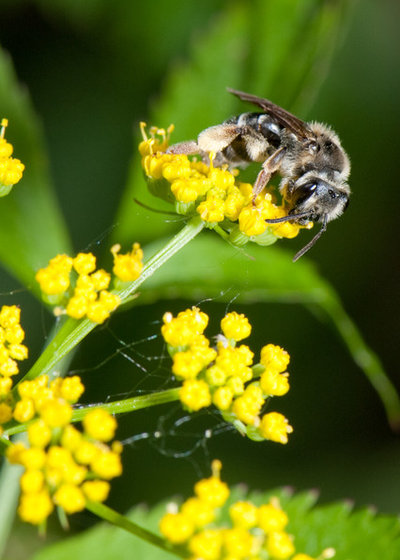
Holm Design & Consulting LLC
How to Lure ThemBesides providing a pesticide-free garden and continuous succession of flowering plants, you will need to provide a place where mining bees can nest. All mining bees nest in the ground; their preferred soil type ranges from sandy-loam to silt-loam. Uncompacted, bare soil is ideal, but many mining bees have been found nesting in sparsely vegetated areas, including lawns. It is important to look for bees excavating nests in the spring (or fall) and protect the nests from any disturbance. The nests will resemble ant hills, with a nest opening and soil deposited around the opening. Mining bee nests should be welcomed in the garden.
Maintain a bee-safe yard. Do not use pesticides, especially insecticides, in the garden, particularly on flowering plants or lawn, where many mining bees prefer to build nests.
Shown: A Golden Alexanders Andrena (
Andrena ziziae)
visits Golden Alexanders (
Zizia aurea). This mining bee is a specialist of
Zizia spp.
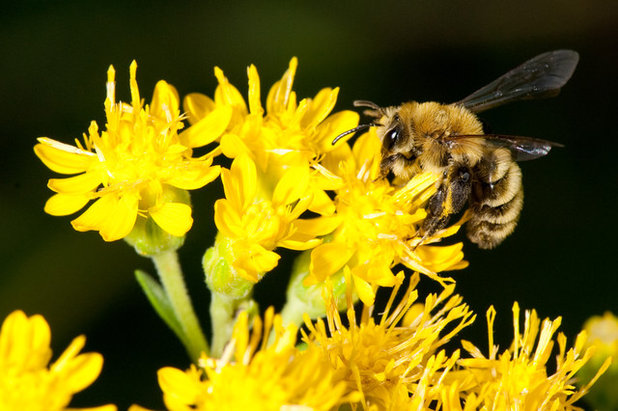
Holm Design & Consulting LLC
Forage plants for adults. Depending on the species, mining bee females are generalists (visiting a wide variety of plants) or specialists (visiting a narrow range of plants). Males do not actively collect pollen so will visit a wide variety of flower forms. Provide both generalist and specialist plants, and select plants native to your particular area.
Sample plant list for adults:- Spring: Bloodroot (Sanguinaria canadensis), wild geranium* (Geranium maculatum), violets* (Viola spp), American plum (Prunus americana), largeflower bellwort (Uvularia grandiflora), serviceberry (Amelanchier spp), Virginia waterleaf* (Hydrophyllum virginianum), American bladdernut (Staphylea trifolia), dogwoods* (Cornus spp), willows* (Salix spp), Golden Alexanders* (Zizia aurea), Jacob’s ladder* (Polemonium reptans), goat’s beard* (Aruncus dioicus) and blueberry* (Vaccinium spp)
- Summer: Yellow coneflower* (Ratibida pinnata), black-eyed Susan* (Rudbeckia spp), purple coneflower* (Echinacea spp), lead plant (Amorpha canescens) and sunflowers* (Helianthus spp)
- Late summer and fall: Goldenrod* (Solidago spp), common boneset (Eupatorium perfoliatum) and asters* (any species)
*Indicates a specialist plant
Browse native plants for your region
Shown: A female hairy-banded Andrena (
Andrena hirticincta) is a goldenrod specialist and is shown here visiting stiff goldenrod (
Solidago rigida).
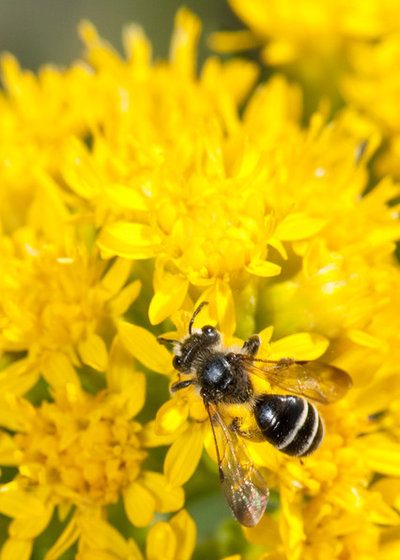
Holm Design & Consulting LLC
Life cycle. In the upper Midwest, Great Lakes and Northeast regions, mining bees usually have one generation per year.
Female mining bees emerge from their nest in the ground as adults, mate with males, then look for a nesting site to begin construction of the nest. Nests are usually solitary; nests can occur in groups, and rarely are communal (multiple females sharing a nest). Nests are excavated by the female; she uses her forelegs to dig a main burrow shaft, and her abdomen and legs push the soil upward out of the excavated hole. From the long, central shaft, short or long lateral shafts are created from which small, oval to round cells for larvae (called brood cells) are excavated. The nest architecture can vary from species to species.
Shown: A female mining bee (
Andrena nubecula)
is an aster (any species) and goldenrod (
Solidago spp) specialist and is shown here visiting stiff goldenrod (
Solidago rigida).
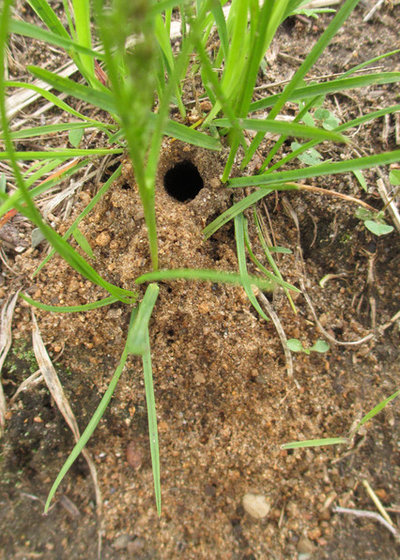
Holm Design & Consulting LLC
Females forage in the landscape and collect pollen and nectar from flowers. These floral resources are combined to form a pollen ball (bee bread) when the female returns to the nest. When enough pollen and nectar have been collected for a given brood cell, the female lays an egg on the provisions and then caps the cell with soil. The capped brood cell is backfilled with soil, often using soil excavated for the next brood cell in the nest.
Vernal (spring-emerging) mining bees overwinter as adults; autumnal species likely overwinter as prepupae. Females may reuse the same nest, excavating and extending their emergence hole.
Shown: A mining bee nest excavated in sandy-loam soil
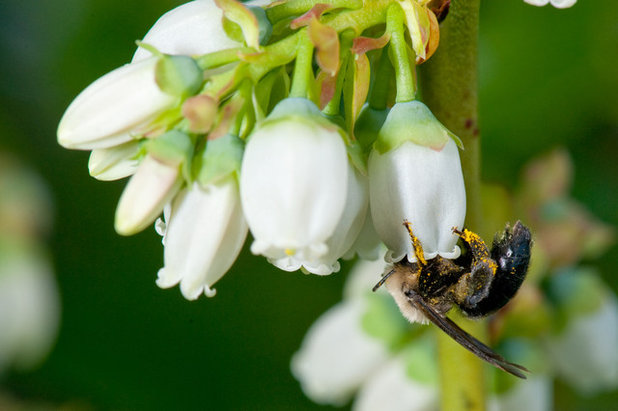
Holm Design & Consulting LLC
Shown: A female mining bee (
Andrena sp) visiting blueberry (
Vaccinium sp) flowers
Region by region: What to Do in Your Garden This Month





